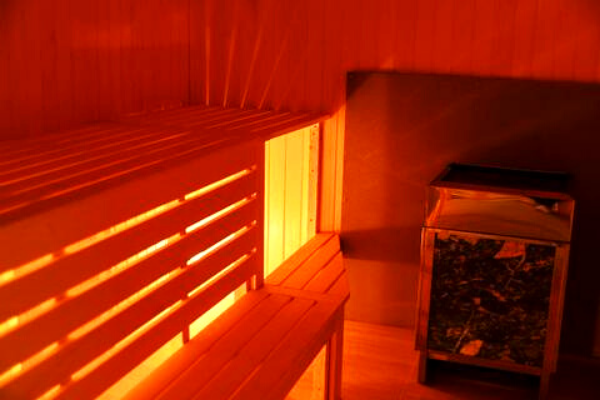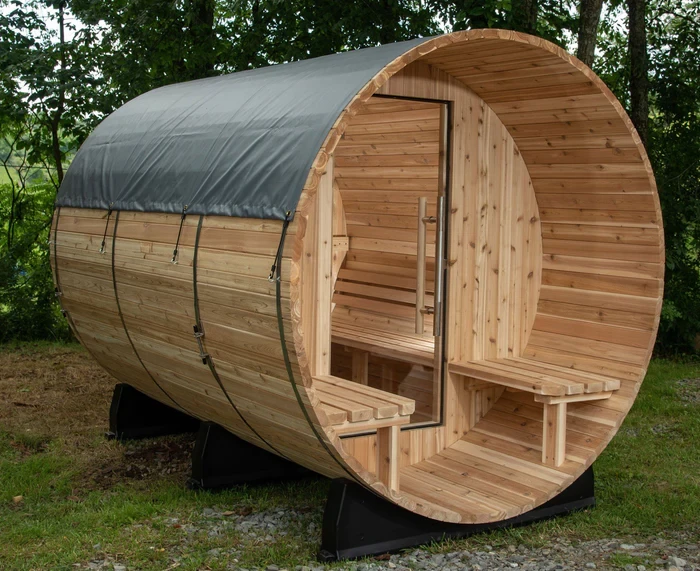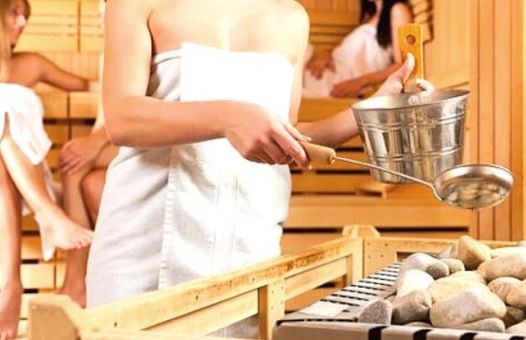YOUR OUTDOOR BARREL SAUNA TEMPERATURE GUIDE
We know from experience that if you want to get your sauna as hot as possible (or, at least make it more efficient), there are a few things you can do to get it to that satisfactory sauna temperature level. So how do you go about it?
We have compiled a list of factors to ensure your outdoor barrel sauna gets to the perfect sauna temperature. And there are two major ways you can improve the temperature of your sauna: covering it and enhancing your heater. The tips we share here will work for both electrical and wood-burning heaters.
Read on to learn how to improve the temperature of your outdoor barrel sauna with all the options available today.

Increase Your Sauna Temperature By Covering It
Outdoor barrel saunas don’t need insulation as they are built for the outdoors! However, covering the top is a great alternative. Some saunas offer various options. The following is a list of options you can use to cover your sauna.
Rain Jacket
A rain jacket is a great option. Such an option ensures you protect your sauna from heavy loads of rain or snow, making it easier to heat up to higher temperatures. It works by offering benefits such as:
-
It’s removable
-
You can choose different colors
-
Keeps moisture out
-
UV resistant
-
Waterproof

Corrugated Metal Roof
You can easily access this at any local hardware store.
Roof Shingles
These are individual shingles that may take longer to add when assembling your sauna, but they do look quite handsome on the finished product! Shingles also allow you to control the amount of space you want to cover. You can get them in different colors and styles to suit your preferences.
Covered Awning
One of the great things about this option is you get to fully customize your cover’s appearance. You can build your own or use a pre-existing structure like an awning or underneath your second story porch,
Extra Sealant
If you have drafts or leaks in your sauna, you can use the steps below to seal any leaks within your sauna:
-
Start by checking the door hinges to ensure they don’t slip. Use a piece of leather stripping to seal unnecessary spaces around your door.
-
Make sure you add as many wooden staves as possible. Ensure all bands are tight.
-
Check the window and make sure it doesn’t leak.
-
Make sure there aren’t any spaces that may cause a leak.
Increase Your Sauna Temperature By Enhancing Your Heater
The main factor that affects your sauna temperature is the heater. Both wood-burning and electric heaters reach a maximum of 195 degrees Fahrenheit. Take note that the type of stones, wood you use, and size of the heater affects the sauna’s ability to produce and retain heat. Let’s take a look at the heating options for an outdoor barrel sauna and their advantages and disadvantages.
The size of your sauna heater is crucial to the outdoor barrel sauna’s performance. Large sauna stoves allow you to reach the ideal sauna temperature more quickly, but they might take up more internal space. Smaller heaters might fit nicely, but may take longer to warm your sauna space. When it comes to what you prefer, the choice is yours! With every sauna product, we have recommendations for heaters based on the sauna size, but you’re welcome to increase the KW or opt for a different heater altogether.
The following are tips to ensure you size your heater properly:
-
The majority of saunas have a ceiling height of 7 feet or lower. Taller saunas need different heating requirements.
-
Every 45 cubic feet in the sauna’s interior requires 1 KW of heater power
-
For every 10.75 square feet of uninsulated wall, increase the volume by 42 cubic feet.
-
Try increasing the size of your heater if you live in a cold region. Make sure the increase in size doesn’t affect your measurements.
-
The majority of outdoor barrel saunas need a heater with a rating of 5 to 8 KWs.
Wood-burning Heaters
For starters, wood-burning heaters are cheaper than their electric counterparts. Apart from eliminating the hassle associated with electric wiring, they also give an authentic spa feel. On the downside, they make it harder to control temperatures, take more time to reach the desired temperatures, and require a chimney.
SIGN UP. SAVE BIG.
Subscribe to be the first to know about our special monthly sauna sales, sent right to your inbox.

Now, when it comes to the type of wood you're burning, this can also have an effect on your sauna temperature. When selecting wood logs for your heater, opt for wood types that are seasoned, clean, and easily accessible. Never go for wood that is freshly cut, stained, painted, or has broken knots.
Softwoods are the best option when you are starting your fire. Examples of great softwood options are spruce, fir, redwood, cedar, and pine. Hardwoods burn slower making them a great option for fuel. Take note that they are a more expensive option. Examples of hardwood options are birch, poplar, cherry, walnut, maple, and oak.
For a better heating experience, opt for an inside feed. This means that you “feed” the heater wood from inside the sauna, rather than from outside. And inside feed provides better ambiance and is more convenient.
Pros of the Wood-Burning Stove:
-
No need for electrical wiring - can work off-grid!
-
Aromatically pleasing
-
Affordable
-
Authentic feel
Cons of the Wood-Burning Stove:
-
Wood may be costly
-
Takes longer to heat
-
Harder to control temperatures
-
Requires a chimney kit
Electric Heaters
Electric heaters offer more convenience, and can be programmed or used with Wifi to heat your outdoor barrel sauna quickly. They are convenient to use and some have a safety feature for automatically resetting the heater after 1 hour.

Pros of the Electric Heater:
-
1-hour automatic reset
-
Options for Pre-programming and Wifi
-
Quick heating
-
Convenient - turn them on with a flip of a switch
Cons of the Electric Heater:
-
Only works when there is power
-
Will need a licensed electrician to help you hardwire it
-
Affects your electricity bill
Additional Factors That Can Affect Your Sauna Temperature
The Vents
Some saunas come with two vents. One of them is by the ceiling and it’s designed for exhaustion. The other is underneath the heater and it’s designed to pull in the fresh air. The following are recommendations for using your vents:
-
Warm up your sauna heater with your vents open. This ensures the high-limit sensor is not activated.
-
To avoid cold air from getting in your sauna’s bottom, keep the corks in the drain stave
-
Close the vents when you are using the sauna. Open them up if you feel the air is too stuffy.
The Humidity
Controlling your humidity levels is one of the advantages of using a traditional outdoor wood sauna. To create a burst of steam, add more water to your stones. Naturally, wet heat and dry heat are the same when it comes to their temperature. However, wet heat feels hotter to your body than dry heat.
Avoid dumping water on the sauna stones. Alternatively, find a way to drizzle water evenly on them. You can try using a bucket and a ladle for the best results.

The Sauna Stones
Sauna heaters that use the wrong sauna stones don’t work efficiently. For example, never use stones from your yard. For the stones to work, they need to be a certain type and a certain weight,otherwise, they won’t be able to retain heat. Sauna stones act as a heatsink and that’s why they allow for steady and slow heat over time.
It’s always advisable to stick with designated sauna stones because of benefits such as:
-
They disperse heat more quickly
-
Better at effective vaporization
-
Maximizes the amount of air circulated
-
Can be safely and easily stacked
The Circulation
Heat rises naturally, so to improve your sauna temperature you need to find a way to make sure air is always flowing. Hot air has a likelihood of getting stuck at the top of your outdoor barrel sauna. To prevent this you can use a small fan. Alternatively, you can wave a towel overhead. Both these options ensure the air is evenly dispersed in the room.
Sauna Maintenance
Sauna heaters don’t require a lot of maintenance. Most heaters can serve you from 5 to 20 years, and regular maintenance will keep them lasting for as long as possible, while ensuring your heater performs as expected. Use the following tips to keep your heater performing at optimum levels:
-
Clean the outer casing regularly. You can use water, a soft cloth, baking soda, or a mild cleaner.
-
Wipe the interior of your sauna regularly. This prevents build-up caused by hard water.
Bottom Line When it Comes to Increasing Sauna Temperature
You can improve your sauna temperature using several methods. You can start by covering the top using corrugated metal, a tarp, roof shingles, or a rain jacket. Alternatively, you can build a customized cover. Secondly, make sure that your sauna is well-sealed. You can do this by examining the window(s), wooden staves, door, and other areas with the probability of leakages.
Make sure you have the best heater for your sauna and you have the right amount of sauna stones. When you start a session, close your vents and reopen them if it gets too hot. To keep humidity levels high gradually add water to your stones. Ensure there is sufficient air circulation by fanning hot air.
If you need more information on how you can improve the temperature of your outdoor barrel sauna, contact us! We will be happy to help! And in the meantime, feel free to browse our selection of outdoor saunas as well as the electric and wood-burning heaters we have to offer.